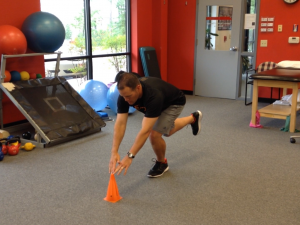Brian Schiff’s Blog
Injury Prevention, Sports Rehab & Performance Training Expert
Unfortunately, I see far too many patients following ACL reconstruction in my sports medicine practice. In any given month, I am rehabbing between 10 and 15 patients who have lost their season to this injury. Most of the time it is a non-contact mechanism of injury, often involving additional trauma to the collateral ligaments, menisci and/or cartilage within the joint.
Throughout my career, I have rehabbed several hundred athletes with ACL tears. It has always been an area of interest and passion for me as well as prevention. Blending my background in performance training with rehab, I have fostered through much trial and adjustment what seems to be a very effective approach to rehab and return to sport. Rehabbing higher level athletes is much like working on a high performance sports cars.
If you own a high performance vehicle, you would prefer to have it serviced at a dealership where the mechanics are experienced working on similar cars, yes? I feel the same care and application is relevant with ACL rehab. PT that is too aggressive or too conservative can impede progress and negatively impact peak performance.
So many times, athletes and parents alike are singularly focused on the physical rehab necessary after an injury. Often, what the athlete is not talking about is the psychological impact of the injury. Suddenly, their identity and self worth may come into question. They feel disconnected from teammates and coaches. Their daily routine consists of rehab and not practice/play. Deep inside their head they are quietly wondering, “Will I ever be the same again?”
Aside from some of the obvious questions that race through an injured athlete’s mind, one of the biggest and most often unspoken concerns is the fear of re-injury. Having worked with athletes of all sports, ages and abilities, I have seen firsthand how important it is for an athlete to go through a functional and sequential progression that assures that they are able to run, jump, cut, pivot and decelerate again without pain or instability.
I have worked with hundreds of athletes over the course of my career that have suffered ACL injuries. The longer I practice, the more I become convinced that we probably have been pushing or allowing these athletes to go back to their sports before they are really ready (physically and/or mentally). Six months has long been the benchmark for most orthopaedic surgeons. The graft is well healed, but often the mind and body are not really ready.
While I have seen athletes who have great strength, stability, hop testing scores above 90% and look good on movement drills, sometimes these same athletes still have asymmetrical squat patterns, FMS scores lower than 14 or apprehension about returning to their sport. In addition, fear of re-injury is a big factor that impacts confidence and readiness to return to activity.
Consider some of these facts about modifiable factors with return to sports after ACLR from the May/June 2015 Sports Health Journal:
- Motivation, confidence, self-efficacy, optimism and low fear are associated with a greater likelihood of returning to preinjury level after athletic injury and ACLR
- Lower fear of reinjury and greater pyschological readiness to return to sport favored returning to preinjury level after surgery
- Combinable data from 10 studies suggests that fear of reinjury, psychological readiness to return to sport and one’ subjective assessment of knee function were predictive of level of return to sport
- As many as 1 in 2 athletes who do not return to their preinjury level of sport report the main reason is fear of reinjury
Whether doing prehab, rehab or training, I believe in using single leg exercises to attack asymmetries, imbalances and motor deficits I uncover in my assessments. Learning to control one’s body in space with the effect of gravity in a weight bearing position is instrumental for sport and injury prevention.
Furthermore, facilitating ankle mobility and proper knee alignment during a loaded squat pattern is something most athletes and clientele I work with need some help with. to that end, I utilize several different single leg reaching progressions and exercises. One of my favorite ‘go to’ exercises is the anterior cone reach.
I recently featured this specific exercise in my ‘Functionally Fit’ column for PFP Magazine. Click here to see the video demonstration.
This is a great exercise with progressions and regressions for clients of all ages and abilities.

So, I just returned from the Combined Sections Meeting for the APTA that was held in Indianapolis. There was lots of great networking and presentations to be sure. I attended sessions on ACL rehab/prevention, femoroacetabular impingement, elbow injuries in throwers, running gait analysis, and shoulder plyometric training with the legendary George Davies. I thought I would give you my top 10 list of helpful nuggets I picked up over the weekend in no particular order of importance.
1. Performing upper body plyometrics has no effect on untrained subjects so don’t waste time putting it into the rehab program, where as it does benefit trained overhead athletes. The one caveat is it also increases passive horizontal external rotation so keep this in mind when working with athletes who have shoulder instability.
2. A new study coming out in 2015 in AJSM revealed no major differences in throwing kinematics between those following UCL reconstruction (Tommy John) and age-matched controls. This is good news for those worried about pitching mechanics after the procedure.
3. According to Dr. Reiman at Duke, the orthopedic hip exam does a better job of telling us they do not have a labral tear than it does telling us they do have an intra-articular problem. The tests have poor specificity. In fact, he goes on to say that the “special tests are not that special.” That brought a chuckle from the crowd including me. Bottom line – we are not really able to conclusively say “yes you have a labral tear based on my exam today.
4. Reiman also feels we must consider look for mechanical symptoms during the lowering portion of the Thomas test, while considering the fact that fat pad impingement may cause anterior hip pain as opposed to joint pain. Again, things are not always as they appear in the “FAI” crowd so we need to take a great history, look at the classic tests and also see how squatting and loading affects the hip.
5. More experienced pitchers do not drop the glove side arm, but instead tend to move their body toward the glove to conserve angular momentum and overcome small moments of inertia. Less experienced pitchers rotate their trunk sooner in pitching cycles whereas pitchers who threw at higher levels rotated later and produced less torque at the shoulder. Consequently, many players with higher elbow valgus torque and distraction force at the shoulder rotate too early.

Every month there are new papers on ACL surgery and rehab appearing in the literature. I do my best to stay up on them as this is one area of my practice I am extremely passionate about. I am driven to understand as much as I can about both prevention and rehab, but find myself increasingly focused on preventing secondary ACL tears in my patients.
I feel poor movement patterns, muscle imbalances and inefficient neuromuscular control are major risk factors for athletes suffering a primary ACL tear. We also know being female markedly increases injury risk. Research also tells us that males are more likely to suffer a re-tear of the same side, whereas females are more likely to suffer a contralateral injury.
A study just published in the July issue of the American Journal of Sports Medicine looked at the incidence of second ACL injuries 2 years after a primary ACL reconstruction and return to sport. In a nutshell, the findings were:
- 24 months after ACLR and return to sport, patients are at greater risk (6x) to suffer a subsequent ACL tear compared to young athletes w/o a history of ACL injury
- Female athletes in the ACLR group are 5x more likely to suffer a second injury
- The contralateral limb of female athletes is at greatest risk
Click here to read the full abstract
This information is not surprising as I have seen it firsthand in 17 years as a physical therapist. What we do not have much information about is how do the younger patients (e.g 15 and under) really recover from this injury. When should they be cleared? I worked with a young female soccer athlete who tore her ACL and medial meniscus at age 13. She worked diligently with me in rehab 3x/week for about 6 months and then continued training with me at least 2x/week until she was about 1 year out from surgery.




